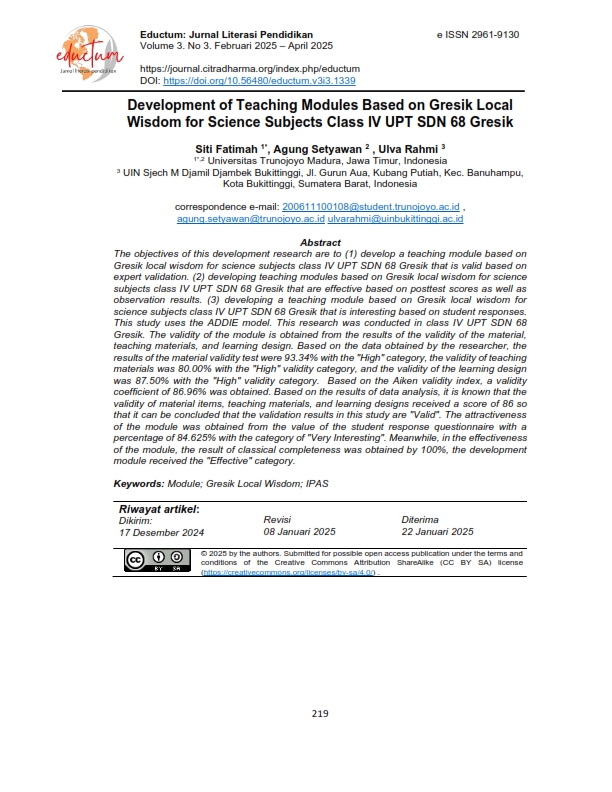Development of Teaching Modules Based on Gresik Local Wisdom for Science Subjects Class IV UPT SDN 68 Gresik
DOI:
https://doi.org/10.56480/eductum.v3i3.1339Keywords:
Module, Gresik Lokal Wisdom, IPASAbstract
The objectives of this development research are to (1) develop a teaching module based on Gresik local wisdom for science subjects class IV UPT SDN 68 Gresik that is valid based on expert validation. (2) developing teaching modules based on Gresik local wisdom for science subjects class IV UPT SDN 68 Gresik that are effective based on posttest scores as well as observation results. (3) developing a teaching module based on Gresik local wisdom for science subjects class IV UPT SDN 68 Gresik that is interesting based on student responses. This study uses the ADDIE model. This research was conducted in class IV UPT SDN 68 Gresik. The validity of the module is obtained from the results of the validity of the material, teaching materials, and learning design. Based on the data obtained by the researcher, the results of the material validity test were 93.34% with the "High" category, the validity of teaching materials was 80.00% with the "High" validity category, and the validity of the learning design was 87.50% with the "High" validity category. Based on the Aiken validity index, a validity coefficient of 86.96% was obtained. Based on the results of data analysis, it is known that the validity of material items, teaching materials, and learning designs received a score of 86 so that it can be concluded that the validation results in this study are "Valid". The attractiveness of the module was obtained from the value of the student response questionnaire with a percentage of 84.625% with the category of "Very Interesting". Meanwhile, in the effectiveness of the module, the result of classical completeness was obtained by 100%, the development module received the "Effective" category.
References
Akbar. (2017). Instrumen Perangkat Pembelajaran. Bandung: Pt. Remaja Rosdakarya.
Aryani, N., & Wahyuni, M. (2021). Belajar dan Pembelajaran Teori Beserta Implikasinya. Yogyakarta: Bintang Pustaka Madani.
Cahyadi, R. A. H. (2019). Pengembangan Bahan Ajar Berbasis Addie Model. Halaqa: Islamic Education Journal, 3(1), 35–42. https://doi.org/10.21070/halaqa.v3i1.2124
Elisyanti, N. M. S., & Suniasih, N. W. (2020). LKPD Interaktif Berbasis Guided Discovery Pada Pembelajaran Matematika Kelas V Sekolah Dasar. Indonesian Journal of Instruction, 1(3), 146–158. https://doi.org/10.23887/iji.v1i3.32034
Febrianty, Y., Pitoyo, D., Masri, F. A., Anggreni, M. A., & Abidin, Z. (2023). Peran Kearifan Lokal Dalam Membangun Identitas Budaya Dan Kebangsaan. El-Hekam, 7(1), 168–181. https://doi.org/10.32639/jimmba.v3i4.944
Kosasih. (2021). Pengembangan Bahan Ajar. Jakarta: Bumi Aksara.
Kristiyanto, eko noer. (2017). Kedudukan kearifan lokal dan peranan masyarakat dalam penataan ruang di daerah. Jurnal Rechtsvinding Media Pembinaan Hukum Nasional, 6. 159–177. http://dx.doi.org/10.33331/rechtsvinding.v6i2.172
Njatrijani, R. (2018). Kearifan Lokal Dalam Perspektif Budaya Kota Semarang Gema Keadilan Edisi Jurnal Gema Keadilan Edisi Jurnal. 5(September), 16–31. https://doi.org/10.14710/gk.2018.3580
Setyosari, P. (2016). Metode Penelitian Pendidikan dan Pengembangan (keempat). Jakarta: Kencana.
Siombo, M. R. (2019). Kearifan Lokal Dalam Proses Pembuatan Tenun Ikat Timor (Studi Pada Kelompok Penenun Di Atambua-Ntt). Bina Hukum Lingkungan, 4(1), 97. https://doi.org/10.24970/bhl.v4i1.88
Soesilo, A., & Munthe, A. P. (2020). Pengembangan Buku Teks Matematika Kelas 8 Dengan Model ADDIE. Scholaria: Jurnal Pendidikan Dan Kebudayaan, 10(3), 231–243. https://doi.org/10.24246/j.js.2020.v10.i3.p231-243
Sugiyono. (2017). Metode Penelitian Kuantitatif, Kualitatif, dan R&D. Bandung: Alfabeta.
Triwiyanto, T. (2021). Pengantar Pendidikan (Y. sri Hayati (ed.). Jakarta: Bumi Aksra.

Downloads
Published
Issue
Section
License
Copyright (c) 2025 Siti Fatimah, Agung Setyawan, Ulva Rahmi

This work is licensed under a Creative Commons Attribution-ShareAlike 4.0 International License.
Authors who publish with this journal agree to the following terms:
- Authors retain copyright and grant the journal right of first publication with the work simultaneously licensed under a Creative Commons Attribution-ShareAlike 4.0 International License that allows others to share the work with an acknowledgment of the work's authorship and initial publication in this journal.
- Authors are able to enter into separate, additional contractual arrangements for the non-exclusive distribution of the journal's published version of the work (e.g., post it to an institutional repository or publish it in a book), with an acknowledgment of its initial publication in this journal.
- Authors are permitted and encouraged to post their work online (e.g., in institutional repositories or on their website) prior to and during the submission process, as it can lead to productive exchanges, as well as earlier and greater citation of published work (See The Effect of Open Access).

This work is licensed under a Creative Commons Attribution-ShareAlike 4.0 International License.
Deprecated: json_decode(): Passing null to parameter #1 ($json) of type string is deprecated in /home/citra-dharma-journal/public_html/plugins/generic/citations/CitationsPlugin.inc.php on line 49













